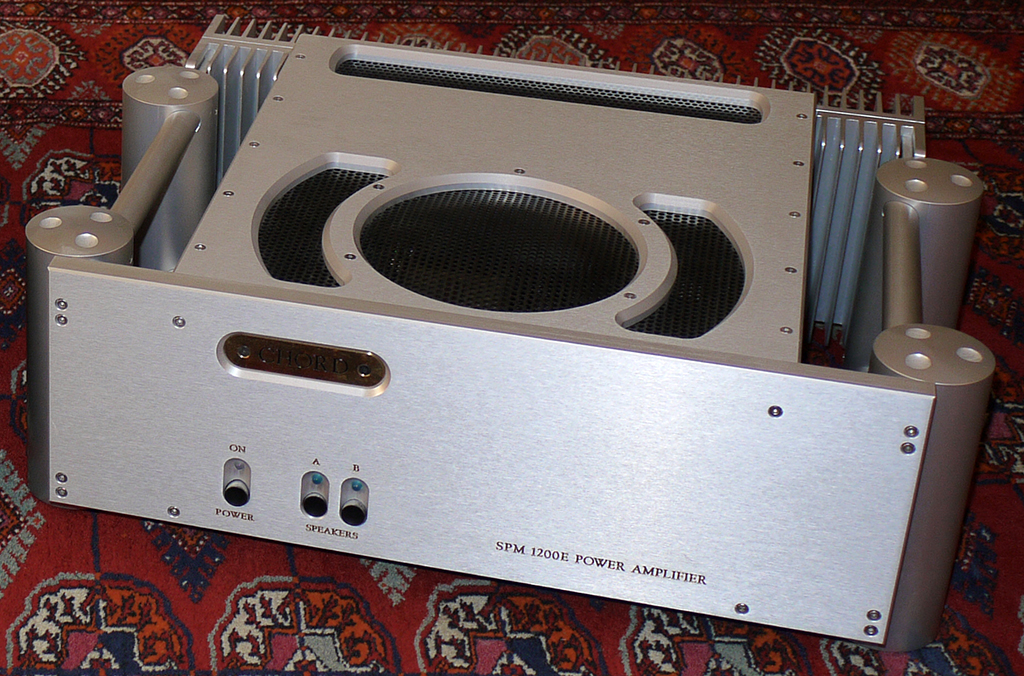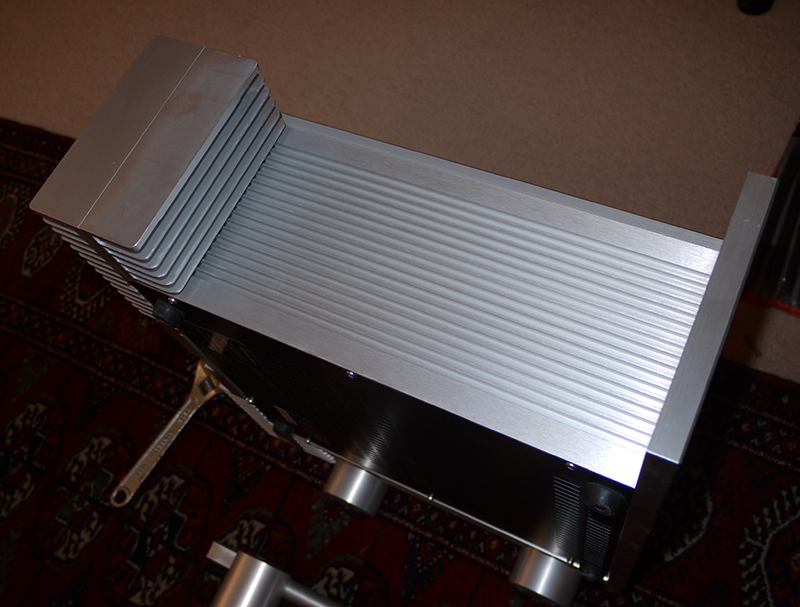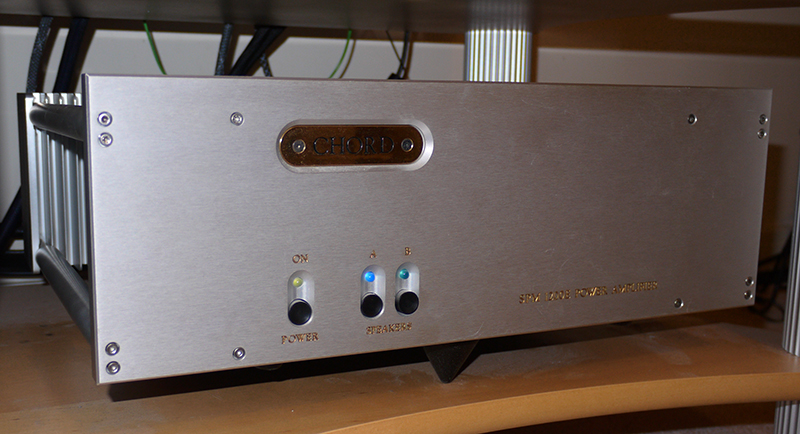|
|
Post by MartinT on Jun 17, 2014 21:33:29 GMT
I have owned this amplifier for 13 years now, making it the oldest surviving hi-fi component still running in my system. There's a good reason that it hasn't been ousted by any other power amp I've tried in my system: none of them have outperformed it. Some have come close, but many have disappointed me.

The Chord SPM-1200E is a 350W per channel MOSFET power amplifier that has a sliding bias arrangement, all driver circuitry running in class A and dynamic coupled power rails. It has all-important balanced inputs and two sets of heavy duty WBT speaker terminals. It is virtually maintenance-free (I've only sent it back once for a service where Chord changed a few distortion setting resistors and pronounced it as good as new) and just goes on working no matter what. There are 16 power MOSFETs per channel. It runs dead quiet and consumes little power (about 40W at idle) meaning that it can be left on permanently, which aids sound quality.
The unusual aspect of the Chord's design is a high frequency high performance switched mode power supply, making it quite compact for its rated output. The fact that the SMPS runs at such a high frequency, with very short recharge cycles to the reservoirs, is why I find it such a fast amplifier, turning on a sixpence when responding to big transients. It also runs cool at all times, never getting more than warm when I'm pushing some serious decibels. One thing that is hard to comprehend is that, despite the SMPS, it responds very well indeed to regenerated power, sounding even cleaner and more dynamic.
It's very hard to describe the Chord, which is why this review is going to be unusually short. It doesn't sound of anything but constantly responds to system changes by remaining ultra revealing. It is like a wide open window, just powering the speakers with immense control no matter what it's driven with. You do not want to use this amp in a poor system as it will simply show up all system deficiencies. I think this is why Chord power amps have an undeserved reputation for being cold and hard. It is nothing of the sort, which a quick listen to my system will confirm. It just plays what it's fed. It seems to have almost limitless headroom and bass power as I have never even come close to hearing it clip or struggle at all. I think my speakers would blow first.
So there is little danger of the Chord leaving my system any time soon, despite its age. I cannot give a better recommendation than that. |
|
|
|
Post by ChrisB on Jun 17, 2014 22:09:36 GMT
It's lovely Martin. It's a shame that they're rarely heard by the hi-fi masses outside of a poorly matched show system. I suppose the upside would be that it will keep the secondhand price low for those who see the potential!
|
|
Deleted
Deleted Member
Posts: 0
|
Post by Deleted on Jun 18, 2014 4:43:34 GMT
Hi Martin, The SMPSU I think was designed by Walter Halliday, he Mr. Franks and I all worked for the same company in Scotland called Minebea near Port Glasgow.
Walter was a fantastic power supply designer and good friend I learnt lots from him, he died one Christmas Day with all is family around him.
|
|
|
|
Post by John on Jun 18, 2014 6:14:46 GMT
Its a beast of a amp but manages to control the Ushers really well
A shame Chord do not put more effort into system matching at shows
|
|
|
|
Post by MartinT on Jun 18, 2014 6:49:49 GMT
Hi Martin, The SMPSU I think was designed by Walter Halliday, he Mr. Franks and I all worked for the same company in Scotland called Minebea near Port Glasgow. Walter was a fantastic power supply designer and good friend I learnt lots from him, he died one Christmas Day with all is family around him. That's very interesting to know, Colin. I had always though it was John Franks who designed the SMPS. Fantastic design, the real powerhouse behind their amps.
As an aside, when I worked for a computer service company back in the 1980s, I became expert at repairing switched mode power supplies. The other engineers would all give them to me to repair as they were (rightly) scared of them. I got to know whether it was a dead oscillator, shorted flyback transistor or open/short circuit main reservoir cap. It was satisfying work but always a moment of deep breath turning them on after repair. Sometimes we would get a 'snowstorm' after a cap blew, which was loud and very pretty!
|
|
|
|
Post by MikeMusic on Jun 18, 2014 7:31:45 GMT
Martin brought this to me to be blown away by my monster a Naim 500, heavy as a truck with separate PSU
'Course it wasn't
Guess what I bought next ?
Crazy price on Ebay, just been serviced. Sounds superb.
Cons ?
Could do without those very bright blue LEDs and would prefer a shallower mains connection
|
|
|
|
Post by MartinT on Jun 18, 2014 7:37:27 GMT
Yep, the deeply recessed 16A IEC is a pain.
|
|
|
|
Post by MikeMusic on Jun 18, 2014 8:28:00 GMT
I have yet to fettle my Kaiser IEC to allow deeper fitting, too much else getting in the way and hopefully big steps forward on Sunday with different size Mana racks, to fit the newer kit and loads of soundbases to improve sound further.
|
|
|
|
Post by MartinT on Jun 24, 2014 19:46:27 GMT
See here for an interesting experiment with RDC 1 Cones. |
|
|
|
Post by MikeMusic on Jun 24, 2014 20:25:14 GMT
There is a small improvement with Superpods
I'll look to see if the MCRU cones are high enough and try them too
|
|
|
|
Post by MartinT on Jun 24, 2014 21:24:34 GMT
I'll see if I can remove the Integra legs tomorrow. I'll take a photo if it's all successful.
|
|
|
|
Post by MikeMusic on Jun 25, 2014 8:01:49 GMT
Looks doable but quite long winded. Perhaps just one Allen key required
|
|
Deleted
Deleted Member
Posts: 0
|
Post by Deleted on Jun 25, 2014 14:20:12 GMT
Hi Martin, The SMPSU I think was designed by Walter Halliday, he Mr. Franks and I all worked for the same company in Scotland called Minebea near Port Glasgow. Walter was a fantastic power supply designer and good friend I learnt lots from him, he died one Christmas Day with all is family around him. That's very interesting to know, Colin. I had always though it was John Franks who designed the SMPS. Fantastic design, the real powerhouse behind their amps.
As an aside, when I worked for a computer service company back in the 1980s, I became expert at repairing switched mode power supplies. The other engineers would all give them to me to repair as they were (rightly) scared of them. I got to know whether it was a dead oscillator, shorted flyback transistor or open/short circuit main reservoir cap. It was satisfying work but always a moment of deep breath turning them on after repair. Sometimes we would get a 'snowstorm' after a cap blew, which was loud and very pretty!
|
|
Deleted
Deleted Member
Posts: 0
|
Post by Deleted on Jun 25, 2014 14:28:53 GMT
Hi Martin,
Interesting when I worked for ICL all the engineers brought the dead SMPSU to me, most were cowards, I liked the small and sometime loud bangs as 1 - 5KW SMPSU died.
Flybacks, Forwards and Full Bridge Resonant s,That was when a computer filled a large room and a 1Meg drive looked like a washing machine.
Fun days but great training.
I went on to design massive linear power supplies 55V at 100KA for BT to charge batteries in Telephone Exchanges.
The on and on until designing audio was no longer a side job but a full time employment. With the occasional branching back to my old trade.
Sorry about the late reply I have been very busy again with a large SMPSU with a clocking frequency of 1-1.2MHz.
|
|
|
|
Post by MartinT on Jun 25, 2014 18:37:47 GMT
Removing the Chord Integra Legs
You need 3mm and 2.5mm hex keys. Take one side at a time. With the 3mm key, undo four bolts at the front holding the two bars in place. Undo two bolts at the rear through the heatsink, holding the bars. Now loosen (but do not remove) two further hex bolts through the heatsink holding it to the main chassis. This gives you just enough play to gently slide the bars/legs assembly out through the heatsink fins.
Showing one side with the bars/legs removed.

Use the 2.5mm key to loosen the grub screws holding the legs to the bars and slide off. Be careful to note which way round the bars fitted. Now re-fit the bars to the amplifier, tightening everything up (including the two bolts you loosened). Repeat for the other side.
Showing the amplifier with legs removed and standing on three RDC 1 cones.

The first thing to note is that all four of my legs were loose, with the grub screws barely nipped up. They rattled noticeably on the bars. There is no access to the grub screws except through disassembly as above. But forget them and the legs forevermore because...
...the amplifier sounds better without them! Everything is a tiny bit cleaner, more focused, more evident in the mix. All those 'tinys' add up to quite a noticeable improvement overall. I find myself listening to different things compared with what I usually listen to in familiar material, because those other things have made their presence known. There's lots of it, all over well recorded music.
The Integra legs are going back in the box as my 'nude' Chord now sounds better than ever  |
|
|
|
Post by MikeMusic on Jun 25, 2014 20:21:44 GMT
I did wonder about them legs.
They are coming off my 2600 tomorrow !
Will fit the Mana rack then rather than perch on the top
|
|
|
|
Post by MartinT on Jun 25, 2014 20:46:36 GMT
...and your 1200E soon?
|
|
|
|
Post by MikeMusic on Jun 26, 2014 7:08:17 GMT
My 1200E has no legs !  |
|
|
|
Post by MartinT on Jun 26, 2014 7:38:52 GMT
Fantastic - already converted!
|
|
|
|
Post by MikeMusic on Jun 26, 2014 10:22:31 GMT
No in the interests of honesty, truth and decency...... That pic's gonna have to go !  |
|




